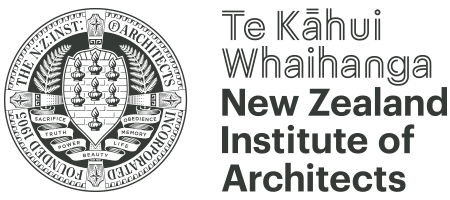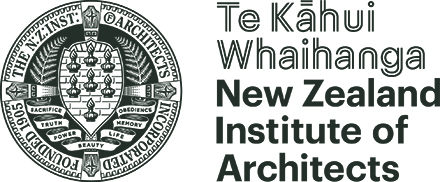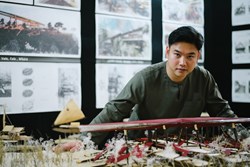Te Kāhui Whaihanga New Zealand Institute of Architects was founded in 1905 but received the gift of a new name in 2019.
In 2019, following the 2017 signing of a kawenata (covenant) between the New Zealand Institute of Architects (NZIA) and Ngā Aho, the Māori designers’ organisation, the Institute was gifted a Māori name by the eminent teacher, broadcaster and writer Dr Haare Williams, MNZM. The words 'Te Kāhui Whaihanga' have now been incorporated into the Institute’s title.
To summarise: Te Kāhui is a group of people covered by a cloak that embraces the deeper meanings of knowledge – the taonga of knowledge. Whaihanga is to build. Whai is to pursue, hanga is to shape, so Whaihanga is to build – a house, a nation, a people.
The gift of a new cloak
Dr Haare Williams (Te Aitanga-a-Māhaki, Rongowhakaata, Ngāi Tūhoe) and former NZIA Councillor Elisapeta Heta (Ngātiwai, Waikato Tainui) discussed the genesis and meaning of the new te reo title with John Walsh, our former Communications Director, over a cup of tea in Dr Williams’ Papakura home. The following is an extract from that conversation – to read the full interview, download a free copy of Tapoto 2 in our online shop.
JW What was your approach when considering a Māori name for the NZIA?
EH There ended up being a big kōrero about the Māori name for the Institute. We started out talking about a name that could be translated into te reo and back into English, more or less, but the discussion became deeper than that.
HW We decided to bring it down to conceiving and expressing an idea, not just for a building but for building a nation and building people as well. Shaping people – it’s that kind of vision. The name Te Kāhui Whaihanga is not only about architecture, but it’s also about building a nation; building a future and building a people. It’s to do with identity.
JW Haare, could you break down the elements of the phrase?
HW Te Kāhui is a group of people covered by a cloak that embraces the deeper meanings of knowledge – the taonga of knowledge. The cabinet in Parliament is known as a kāhui; the group that advises the Māori King is known as Kāhui. It’s a group that advises, guides and produces outcomes that are going to benefit its constituents.
Whaihanga is to build. Whai is to pursue, hanga is to shape, so Whaihanga is to build – a house, a nation, a people. Building a house has primary importance in the Māori world. When you walk into a meeting house, you walk into an ancestor; you walk into the womb to be reborn. The meeting house (wharenui) embodies everything that is spiritually, culturally, emotionally and intellectually of great importance in Te Ao Māori.
JW So ‘Te Kāhui Whaihanga’ has a resonance that extends well beyond a simple translation of the English name of the NZIA?
HW It is not a translation of ‘New Zealand Institute of Architects’. It’s really an interpretation. It’s a name that advances an idea to another level. This idea of Kāhui Whaihanga is about the ecology of a building, the whakapapa of a building, the way that a wharenui needs to be built by the people from the ground up. I’ve got a poem: “One, two, three, lift, and everyone lifts the tāhuhu up to the top.” One lift to lift the ridge pole up to the top. That’s what a wharenui is about. It takes people to put it into place and put its backbone into place. It’s hugely important.
I believe the Treaty has become a watershed for New Zealand. Whatever frustrations Māori have had in the past, the Treaty has always been the talisman for that journey ahead. You have te reo starting to come back and have meaning in Aotearoa New Zealand. You have the NZIA seeking an appropriate Māori name. That name, Te Kāhui Whaihanga, came from rangitahi, from young people – great leadership was shown by them.
JW Those three words – Te Kāhui Whaihanga – convey a much wider meaning than the title of an organisation.
HW Māori don’t separate art, architecture, design, music and poetry. They are a seamless part of our culture. There’s no separation of those elements. Astronomy, astrology, hygiene, art, warfare, agriculture and horticulture, religion, you name it – it’s seamless. I call it our literature rather than our culture because our literature is spoken.
EH The New Zealand Institute of Architects as a name states a fact, where Te Kāhui Whaihanga as a name states an aspiration. I feel it’s so important to be clear about what you’re doing, but to be aspirational or inspirational at the same time. I love the balance of these two names. The NZIA now has an ability to be clear about who it is, as well as potentially to be visionary.
HW I think the values in the kawenata will become integrated with the Institute’s name now. Values like authority and responsibility, knowledge and tikanga (custom) – the protection of not just Māori knowledge but Western knowledge as well. Co-operation, working together, and representation—all of these values are expressed in the kawenata, and in the name Te Kāhui Whaihanga New Zealand Institute of Architects.
Our logo
 Imogen Greenfield, the Manager, Design & Creative at Te Kāhui Whaihanga NZIA, explains how she designed the Institute's new logo.
Imogen Greenfield, the Manager, Design & Creative at Te Kāhui Whaihanga NZIA, explains how she designed the Institute's new logo.
"As the NZIA’s designer it was my job to give graphic representation to the Institute’s new Māori name, and to incorporate the new name in the mark or logo of the organisation.
"There were contextual issues to understand in the first place: where does the name Te Kāhui Whaihanga come from, and what does the term mean? Following on from that, there were graphic challenges to address: how to visually distinguish between the te reo Māori name and the English name without creating a hierarchy. And how to make a visual connection between the wordmark and its meaning.
"Taking inspiration from, but not seeking to replicate, whakairo – Māori traditional carving – and using the form of NZIA’s standard typeface, I developed a wordmark that can fit with the English name but stand independent of it, too. In the mark, the double line used on Te Kāhui Whaihanga creates a unique texture and lightens the weight of the words without sacrificing their importance. It also talks to the meaning of the words – the shaping of a house, or a nation, to create something.
"I also looked at a pattern which could be incorporated into the Institute’s graphic collateral. I thought a weave pattern or motif would be appropriate as what the adoption of a te reo Māori title signifies is the weaving together of the Institute and Māori practitioners. I considered an iteration of the tukutuku pattern, but a discussion with Elisapeta Heta led in the direction of the kupenga, or net, used to gather food. This is another weave motif, and it has a nice allusion to the collection of knowledge and the bringing together of people."
The roundel
The circular component of our logo has been part of the Institute since its earliest days. It is inspired by an essay published in 1849 called The Seven Lamps of Architecture by Victorian art critic John Ruskin. There are several components in the roundel, each of which has its own significance:
- The four stars represent the Southern Cross constellation
- The seven lamps in the middle represent Ruskin's seven 'lamps' of architecture, which are also noted in the banner: sacrifice, truth, power, beauty, obedience, memory and life.
- The ferns represent the silver fern of Aotearoa.



